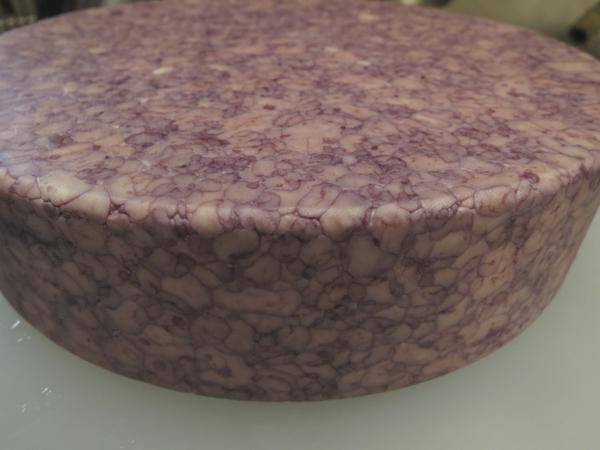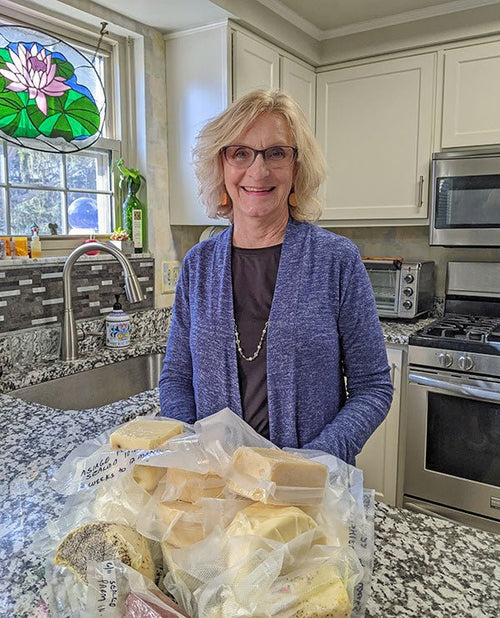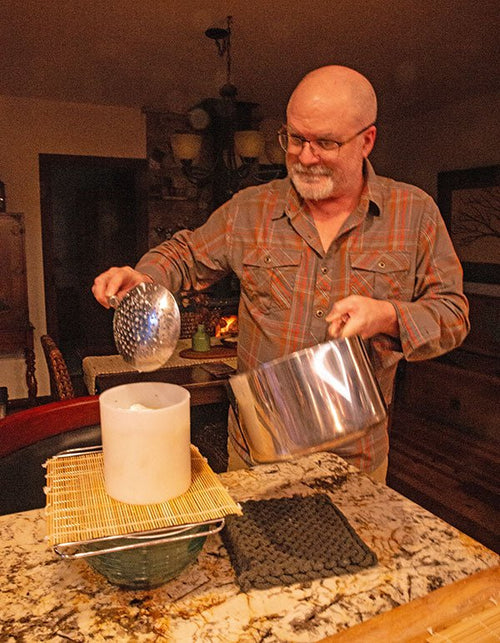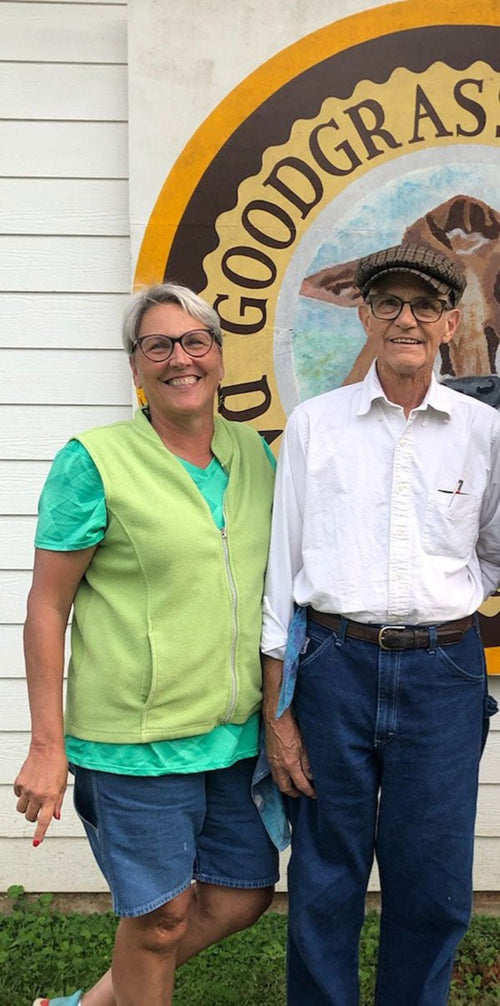Cheese Making Recipe of the Month
Pouligny St. Pierre - Recipe and History
Here's a question for you - why is the top lopped off on these little pyramids? Pick one or more:
- Napoleon cut off the tops with his sword after his unsuccessful campaign in Egypt.
- It's hard to drain a mold that comes to a point.
- The church in Pouligney (France) has a steeple shaped like this.
Answer: We don't know. However, if you do, please share your idea with us ( moosletter@cheesemaking.com) and if it seems even the slightest bit plausible, we will publish it in our next Moos-Letter.
Note: The "point" is that Jim actually does know a LOT about this fabulous goat's milk cheese and it's all included in his recipe. Enjoy!
Cheese Making Questions & Answers
Pinholes in the wax - What do I do about it?
Q. I waxed some cheese for the first time this weekend. Unfortunately, pinholes within the wax are leaking oil/butter fat. Is this a problem? I assume it is. What do I do about it?
A. Always wax two coats - The pinhole problem is quite common and can be easily resolved by doing two coats of wax. The small holes are caused by air bubbles during the waxing process. The solution is to apply the first coat when the wax is at about 125 to 130F and then apply the second coat after the wax has cooled to about 100 to 110F.
Your real problem, however, may be in what is leaking through the wax. Unless you have the cheese sitting in a warm area and it truly is butterfat, the problem is most likely that the cheese is leaking moisture caused by late fermentation. This is normally the result of excessive whey containing lactose being left behind in the curds when molding. It can be corrected in future batches by:
Stirring longer, increasing the temperature by a few degrees, and making sure you have added enough culture to the milk and ripened long enough to convert the lactose to lactic acid.
What should the pH for blue cheese be?
Q. I love your recipe for blue cheese. Do you know what the pH of either the whey or the curds should be when ready to put in the mold?
A. Use your senses to know for sure - As useful as pH can be for monitoring the acid development, we always warn folks not to take it as written in stone. We usually do not bring pH targets into our recipes guides because of this. We have worked with many traditional cheese makers over the years and we rarely see them focusing on this. Instead, they are paying close attention to the changes in milk to curd and into the final cheese. They do this much as their grandparents did - evaluating the process with touch, smell and feel as they go.
But that said, we expect the targets here to reach about 6.2 at 4 hours and 5.3 when draining at 6 hrs. The truth is that we rarely measure, but we can taste the acid when it's right and the texture and feel tells us just as much if not more.
For us, the pH meter and titration are for when things go wrong to clue us in to what is happening. Any time we do use the pH meter, we have pretty much made our physical evaluations before falling back on these tools.
Can I make cottage cheese using MM100 or Flora Danica?
Q. Can I make cottage cheese using MM100 or Flora Danica? (What difference will it make compared to the recommended C101?) It looks like MM100 has one additional strain, the diacetylactis. And the flora danica has two extra strains, compared to the C101.
A. Slight changes - The C101 culture will give you a nice tight curd. Some folks like the clean flavor and compact curds best. The other two cultures produce an extra flavor and a bit of gas to make a lighter textured curd. Some of our customers like the added flavor and softer texture.
Have a cheese making question, we're here for you: info@cheesemaking.com
Meet a Fellow Cheese Maker
Cateland White in Las Vegas, Nevada
Cateland White (56) has been a writer/songwriter, a musician, a gardener and now enjoys a second round of motherhood with Kayde, her very "grand" daughter of 10.
We were honored when she wrote to us with some tips about how to turn your cheese "failures" into delightful alternatives. Apparently she didn't need to learn this sort of thing until she moved to Las Vegas 20 years ago, at which point all her recipes became unpredictable.
Maybe it's the altitude or the temperature, or maybe her good recipes went bad when they became corrupted by the casinos - we don't know. But, we do know that you will enjoy her ideas and her humorous writing style at our fabulous blog.
This spotlight section is a whey to honor cheese makers. Please share your stories and help spread the love of cheese making - moosletter@cheesemaking.com
News From Fellow Cheese Makers
A Perfect Solution!
From one raw milk cheese maker to another:
The question about making yogurt with raw milk prompted me to respond because I make yogurt with raw milk.
I came up with a compromise that seems to work well, in which I scald half of the raw milk (1 quart), then add it to another quart of cold raw milk before stirring in the yogurt starter.
Upon mixing, the temperature drops to about 110F, which is what we want for yogurt. I have retained the enzymes and other goodies from half of it, while gaining the advantages of heating the other half of the milk, so my yogurt is firm and not runny or slimy while still being more nutritious than if I'd heated all of it.
It may not technically be yogurt since only half of it was heated and cooled, but it sure tastes and feels like yogurt. Give it a try!
Nancy Eason, Colorado
Strawberry Quark Cream Torte
I immigrated from Germany some time ago, always missing Quark in my diet, trying to find substitutes like draining Greek yogurt, etc, etc.
I was more than excited when I found your website. You actually knew what Quark was and you offered instructions on how to, along with everything else I needed. Needless to say I got into it right away (easy as pie) and the results - just like Quark in Germany.
In honor of this beautiful outcome, I had to bake my Strawberry Quark Whipped Cream Torte or "Erdbeer Kaese-Sahne Torte." I can't wait for my next batch ...
Michaela Schilling, Concord, NH
Her First!
This was my first aged cheese....I called it Tomme de Oakland. The blue mold on the outside was....unexpected, but I cut it all off and the inside was yummy!
Liz Hudson Silzle, Oakland, CA
Good Moos!!!
From Ricki:
The surgery went very well, thanks to my fabulous surgeon and King of the super-heroes, Steven Schonholtz (who loves chocolate as much as he loves Superman).
We played at the hospital and 6 great friends came with me dressed as super-heroes for the day.
The next day, over 200 hundred people came to roam around my gardens (see our blog article). We had a lot of fun and it kept my mind off the waiting time.
Now, the results are back - the cancer was all taken out with clear margins and for now, I'm done, hurray! I want to thank you all for your notes, beautiful quilt squares and for the loving sentiments you shared with me. I am honored and humbled to have such a wonder-filled extended family around the world! As soon as I put the quilt together, I will share the photos.
My love to you and thank you!
XOXOXO Ricki
Please send your cheese making news & photos to: moosletter@cheesemaking.com
Cheese Making 1,2 & 3
Learn all about the ingredients, equipment and process for making cheese at home. This beginner's guide will walk you through the process from start to finish.
Beginner FAQ's
Got a question? We've got an answer. From milk and cream to rennet and aging, our FAQ section is filled with answers to all your home cheese making questions.











































































































































